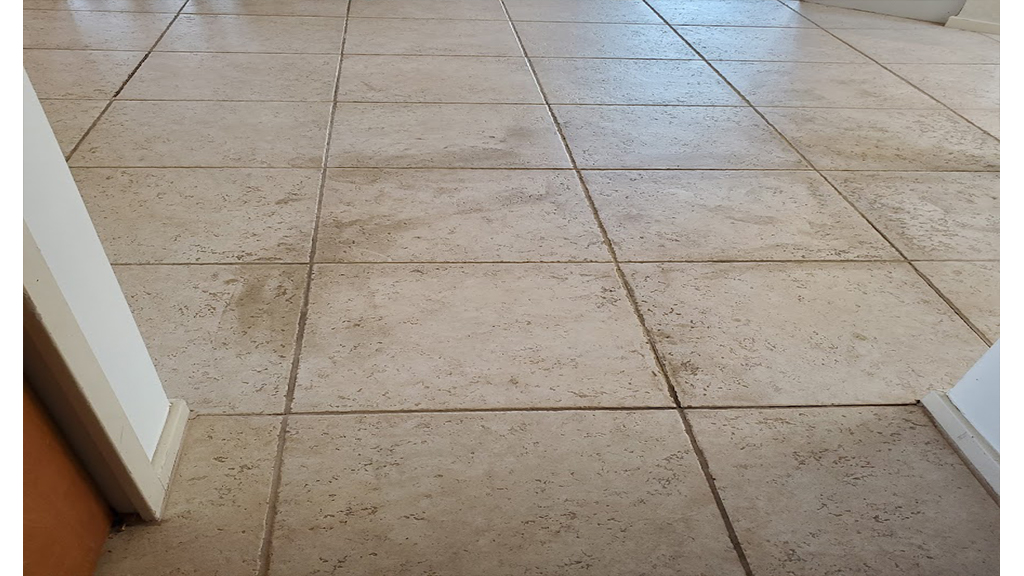Neighbor Refers Us To Clean Moorestown Homeowner’s Grout Haze On His Tile
- Home Case Studies Neighbor Refers Us To Clean Moorestown Homeowner’s Grout Haze On His Tile
For 13 Years Homeowner Struggles With Unsightly Tile In His Large Open Concept Home
Frankly, upon entering it’s the very first thing you see, and the dominating aspect of what you see when in his home. At his wits end he was hoping a professional could do something about it, instead of going to the large expense of replacing it. If faced with replacement it would become an expensive endeavor. A much larger area would have to be replaced (not just the affected area.) The areas that would need replacing include foyer, a large dining room, and large kitchen, hallway and power room, not his first choice for sure.
Riverton Road—New Albany Road Walking Buddies Chat, And Neighbor Refers Us To Help Him
On a routine walking path, neighbors often walk, say hello or chat whose large back yards meet behind Riverton Road and New Albany. Frustrated, the one neighbor vents to the other about a problem floor he has in his foyer, and asks if she has a similar problem. Our prospective client on Riverton knows his neighbor has a similar, contemporary home, and thought he might get a suggestion or guidance. Well, his intuition served him right.
The New Albany Rd Client Overwhelmingly Recommends Us, Saying “Call Sparkle Surface Care,” And Assures Him We Will Help Him
With great assurance and a knack for sizing up service contractors, this sassy New Zealander native did not skip a beat, and told him to call us. (As it turns out we refinished the all the wood floors in her home including her foyer, kitchen, family room, living room and dining room.) We have also cleaned her upholstery and I believe tile before she since had sold her house.) When we worked with her she had a keen eye for detail and way to ‘size up’ who you are, how you work, whether you do what you say, and whether you pass her attention to detail test (and the answer to that was a resounding yes!)
During Our Initial Conversation I Could Tell He Was Frustrated With His Floors and Was Hoping To Find a Cleaning, Not a Replacing Solution
He was indeed really, really frustrated and hoped that there could be a cleaning or restoration solution. It was obvious that he consumed DIY hacks and tried a good many of them, to no avail. He learned about a technique called A poultice—where you make a recipe of powder and agents to apply it to the surface and allow it to absorb. Similar to taking a bath in Epsom Salts, the idea is to draw out the foreign residues and allow them to absorb in to the powder to rid them from the tile. He learned how to mix up the poultice, apply it, and wait. And no, this did not even help.
Not the correct fit for this probable problem, I sensed his problem was grout haze. Most likely it was left behind during the installation or re-grouting process. Stating it came with the house, it was a bit of an eyesore.
What Is Grout Haze
Grout haze is a film of haze left on the surface, (ceramic or stone.) During the grouting process, the installer trowels the grout across the joints and typically across the tile too. The final process involves the installer going back over the floor and removing the residual grout haze (a film on the tiles themselves.) Therefore, it is a bit of a installation error, or sloppy workmanship.
Grout haze doesn’t just wipe off, it may need a little elbow grease. Or if still a nuisance, it may need to be acid washed off. So this is where the story gets funky.
Confident We Could Remove It We Arrived And Set The Truck Up To Clean
Using our truck mount extraction steam cleaning with the hard surface wand, we clean dirty tile and grout (ceramic or stone,) all day long, every day. In the right situation, with soiled grout, our steaming tool, when passing over the soiled grout can come clean right in front of your own eyes—like now you see it, now you don’t. Maybe a little agitation is needed, maybe you need to get a stronger cleaning solution (acid wash.)
For This Project Cleaning— Not Giving Us “A Fit,” But We Had To Work At It, And Acid Wash It
First we steamed it with a basic tile cleaning solution, which did not address the problem “soiling,” haze or efflorescence. We next went to the acid wash, a much stronger cleaner to get at the soiling. Adding a lot of hand scrubbing we finally removed it. Then we tried to remove the deposit type build up so it wouldn’t re-attract new soiling or residue.
If that didn’t work we might have had to get our stone grinding equipment out. And since some of these grinders grind off layers of stone, a process to remove “lippage” (which is uneven stone tiles that can cause someone to trip and fall.) Lippage can be a real trip hazard. It’s considered an installation error and a serious potential problem. Instead of tearing out an uneven stone floor (at times a cost prohibitive alternative,) stone restoration contractors will “delip” a floor with grinders. So clearly overkill perhaps in this case, we did have confidence we’d get it one way or another.
Our Homeowner Is Pleased as Punch—Even If He Needs To Hire Us Yearly He Knows It Can Be Removed Without A Ridiculous Amount of Elbow Grease
Our customer had said after working at it he got it off, but then it would come back again. Usually when that happens with stone, it is a moisture problem. This is not wet. So that is not the explanation. It does behave like an efflorescence, so time will tell if it removes. Even after some shop talk with our supplier, a world renowned stone restoration guy, there seems to be something funky going on.
All in all if the client can count on us to clean it yearly or so, he is perfectly happy, even if it returns. To know there is a solution, the cleaning will keep him from having to spend gobs of money to replace the floor. A fraction of that cost, and cleaning he does not have to muscle through, that’s good enough for him!















